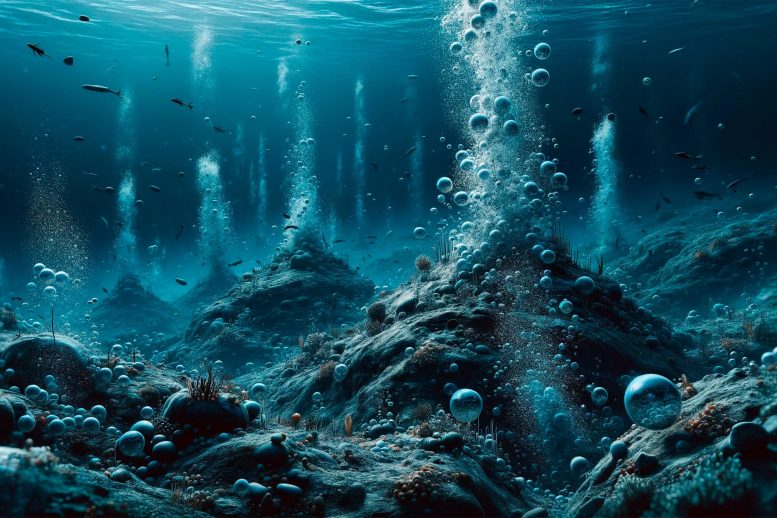
New research reveals that fire-ice, or frozen methane which is trapped as a solid under our oceans, is at risk of melting due to climate change, potentially releasing large amounts of methane into the atmosphere. Using advanced seismic imaging, the team found that dissociated methane can migrate significant distances, challenging previous assumptions about its stability.
Research indicates that oceanic fire-ice, or frozen methane, is vulnerable to melting from climate change, posing a significant threat of methane release into the atmosphere.
An international team of researchers led by Newcastle University found that as frozen methane and ice melts, methane — a potent greenhouse gas — is released and moves from the deepest parts of the continental slope to the edge of the underwater shelf. They even discovered a pocket that had moved 25 miles (40 kilometers).
Publishing in the journal Nature Geoscience, the researchers say this means that much more methane could potentially be vulnerable and released into the atmosphere as a result of climate warming.
Methane Hydrate: A Hidden Climate Threat
Methane hydrate, also known as fire-ice, is an ice-like structure found buried in the ocean floor that contains methane. Vast amounts of methane are stored as marine methane under oceans. It thaws when the oceans warm, releasing methane into oceans and the atmosphere — known as dissociated methane — contributing to global warming.
The scientists used advanced three-dimensional seismic imaging techniques to examine the portion of the hydrate that dissociated during climatic warming off the coast of Mauritania in Northwest Africa. They identified a specific case where dissociated methane migrated over 40 kilometers and was released through a field of underwater depressions, known as pockmarks, during past warm periods.
Newcastle University researchers have found that frozen methane trapped under our oceans, is vulnerable to melting due to climate change and could be released into the sea. Credit: Newcastle University
Discovery and Implications
Lead author, Professor Richard Davies, Pro-Vice-Chancellor, Global and Sustainability, Newcastle University, said: “It was a Covid lockdown discovery, I revisited imaging of strata just under the modern seafloor offshore of Mauritania and pretty much stumbled over 23 pockmarks. Our work shows they formed because methane released from hydrate, from the deepest parts of the continental slope vented into the ocean. Scientists had previously thought this hydrate was not vulnerable to climatic warming, but we have shown that some of it is.”
Researchers have previously studied how changes in bottom water temperature near continental margins can affect the release of methane from hydrates. However, these studies mainly focused on areas where only a small portion of global methane hydrates are located. This is one of only a small number that investigates the release of methane from the base of the hydrate stability zone, which is deeper underwater. The results show that methane released from the hydrate stability zone traveled a significant distance toward land.
Broader Research Perspectives and Future Plans
Professor Dr. Christian Berndt, Head of the Research Unit Marine Geodynamics, GEOMAR, in Kiel, Germany, added:
“This is an important discovery. So far, research efforts focused on the shallowest parts of the hydrate stability zone, because we thought that only this portion is sensitive to climate variations.
“The new data clearly show that far larger volumes of methane may be liberated from marine hydrates and we really have to get to the bottom of this to understand better the role of hydrates in the climate system.”
Methane is the second most abundant anthropogenic greenhouse gas after carbon dioxide (CO2). Figures from the United States Environmental Protection Agency show that methane accounts for about 16% of global greenhouse gas emissions.
The study results can play a key role in helping to predict and address the impact of methane on our changing climate.
The team plans to continue to search for evidence of methane vents along the margin and try to predict where massive methane seeps are likely to occur as we warm the planet. The researchers are now planning a scientific cruise to drill into the pockmarks and see if they can more closely tie them to past climatic warming events.
Reference: “Long-distance migration and venting of methane from the base of the hydrate stability zone” by Richard J. Davies, Jinxiu Yang, Mark T. Ireland, Christian Berndt, Miguel Ángel Morales Maqueda and Mads Huuse, 6 December 2023, Nature Geoscience.
DOI: 10.1038/s41561-023-01333-w
>>> Read full article>>>
Copyright for syndicated content belongs to the linked Source : SciTechDaily – https://scitechdaily.com/fire-ice-time-bomb-discovered-climate-changes-deep-ocean-threat/